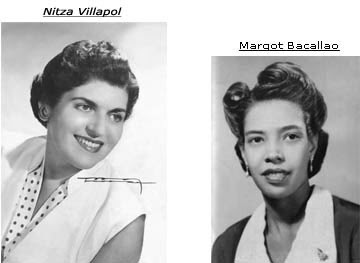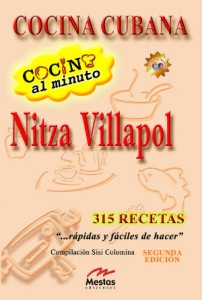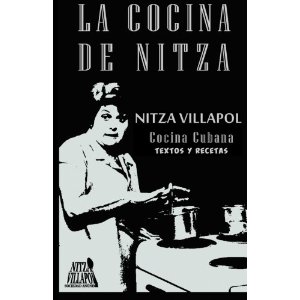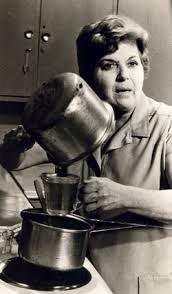 NITZA VILLAPOL,La mujer que escribía de cocina.
NITZA VILLAPOL,La mujer que escribía de cocina.
Sus programas de radio y televisión la hicieron enormemente popular. Sus libros batieron siempre récords de venta y sus colaboraciones en la prensa escrita eran buscadas y conservadas por una infinidad de lectoras –y lectores. Pocos autores abordaron el tema de la cocina cubana con tanta extensión y profundidad como Nitza Villapol.
Su labor fue más allá de la simple recopilación y divulgación de recetas, con todo lo importante que eso pueda ser. La autora de Cocina al minuto, su libro más emblemático y difundido, enfrentó la cocina también como un problema económico y dietético que forma parte de la cultura y la nacionalidad, y lo hizo con un rigor no exento de vuelo artístico. “La cocina –aseguraba- es un arte, un arte de cada pueblo, un arte menor que forma parte de la cultura de los pueblos”.
Se dice que su programa televisivo, por las más de cuatro décadas que se mantuvo en pantalla, podría haber sido asentado en el Libro de Guinness. En un tiempo solo lo superaba, en antigüedad, Meet the Press, de la televisora norteamericana NBC. Pero si este lo aventajaba en cuatro años, Nitza, como conductora, no tuvo rivales: nadie permaneció más tiempo que ella al frente de un espacio de TV. Su contendiente más cercano sería el periodista Lawrence E. Spivak, que llevó veinte y siete años como panelista o conductor del espacio mencionado. Nitza lo hizo durante cuarenta y cuatro años.
Tan larga presencia en la pequeña pantalla impuso la imagen de una mujer simpática, meticulosa, convincente y dotada de un enorme poder de comunicación. El carisma era, sin embargo, solo una de las aristas de Nitza Villapol. Detrás de su aparente desenfado, animaba una mujer de cultura y arduos estudios. Lo demostró cuando la UNESCO le confió la encomienda de escribir el capítulo relativo a la cocina en el libro África en América, que se publicaría en varios idiomas y tiene ya diez ediciones.
“Culta, inteligente, dotada de una rara capacidad de persuasión y profunda conocedora de tan complejas ramas como la nutrición y la dietética, Nitza Villapol es, sin lugar a dudas, la personalidad que más ha influido en el dinamismo y actualización de la cocina cubana, y, sobre todo, en la dificilísima tarea de modificar los hábitos alimentarios del país”, decía en 1986, el escritor Jaime Sarusky en su “Encuentro con la cocina cubana”.
Porque a Nitza le tocó acometer parte de su trabajo en épocas de grandes carencias: primero, cuando a consecuencia del bloqueo norteamericano a la Isla, el cubano se vio privado de productos y condimentos tradicionales en su cocina. Luego, cuando el derrumbe del campo socialista, cortó el suministro de renglones alimentarios que ya se habían hecho habituales en la mesa cubana.
Recordaba Sarusky en su artículo citado que Nitza, en los años 60, enseñó a preparar y a degustar platos como la merluza y la tilapia, desconocidos en la dieta del cubano promedio, lo convenció de las ventajas de cocinar con menos grasa, le reveló el secreto para prescindir de los huevos en la elaboración de un pudín y le dijo cómo empanar la carne con agua y harina como únicos ingredientes. ¿Qué escaseaba la harina para las frituras? Nitza entonces ponía la solución al alcance de la mano: bastaba, para que apareciera, con derretir un paquete de macarrones.
Es por eso que, en opinión de Sarusky, son pocos los que dudan en Cuba que con la magia y los descubrimientos culinarios de esta mujer podría llenarse un delicioso tratado sobre la infinita e inagotable inventiva de los cubanos. Pero Nitza restó siempre importancia al asunto, y en una ocasión confesó: “Sencillamente, invertí los términos. En lugar de preguntarme cuáles ingredientes hacían falta para hacer tal o cual receta, empecé por preguntarme cuáles eran las recetas realizables con los productos disponibles”.
Al desencadenarse en Cuba la crisis económica de los 90, el tema de la cocina se hizo tabú en la Isla, y el programa de Nitza Villapol desapareció del aire de la noche a la mañana. Fue un error, diría más tarde José Luis Santana, presidente entonces de la Federación Culinaria Cubana. “Desde que desapareció el programa Cocina al minuto se ha seguido cierta política errónea de no tocar el tema de la alimentación en los medios. Nuestros hogares se han visto privados de un asesoramiento, de una ayuda, y eso debía rescatarse también”, expresó el chef Santana a la prensa en 1996.
Felizmente, así fue. Pero ya Nitza se había deteriorado mucho para reaparecer en pantalla. Aun así, escribió y publicó nuevos títulos, y se vendieron con el éxito de siempre. La gente, sin embargo, la fue olvidando. Cuando murió, en 1998, solo un puñado de personas acompañó hasta la tumba a la que fue una de las mujeres más populares de Cuba.
Nitza Villapol nació en Nueva York, en 1923. Hija de cubanos emigrados por sus ideas políticas. Diez años más tarde se radicó en la Habana con su familia, y aquí hizo estudios hasta diplomarse como Doctora en Pedagogía, en 1948. En su acercamiento a la cocina hubo mucho de vocación y un poco de casualidad. Gustó siempre de compilar recetas y un día consideró que resultaría útil publicarlas. Su facilidad expositiva, su carisma y su capacidad para comunicarse, la harían sobresalir pronto entre las que realizaban la misma tarea –Ana Dolores Gómez, Nena Cuenco de Prieto, Carmencita San Miguel, María Radelat de Fontanills, María Antonieta de la Reyes Gavilán… Mereció la Distinción por la Cultura nacional.
Hizo un aporte decisivo al estudio de la culinaria cuando concluyó que la cocina comenzó a ser cubana cuando los garbanzos se suprimieron del ajiaco. Hasta entonces, ese sopón, que se nutre de muy variadas carnes secas y frescas, no había sido más que el encuentro del cocido español con las viandas de la Isla.
La degustación del arroz en las dos comidas diarias como cereal básico, la presencia de un guiso que “moje” ese arroz, el gusto por lo frito y la preferencia por lo dulce, son constantes en el paladar criollo, aseguró, y afirmó, además, que la gente se ata más a la forma de elaborar un alimento que al alimento mismo.
Pude ver hace poco una edición de Cocina al minuto hecha en Miami. Hasta donde constaté sigue la letra del libro de igual título que Nitza Villapol y Martha Martínez dieron a conocer en La Habana, en 1959. La única diferencia es que el Cocina al minuto publicado en Miami no consigna el nombre de ninguna de sus autoras.
Ella lo supo muy bien e hizo su legado en más de quince títulos, miles de programas radiales y televisivos e infinidad de columnas de prensa, como la que durante años mantuvo en la revista Cuba Internacional que la tuvo hasta el final entre sus colaboradores más distinguidos. Ahora que ya no está habrá que remitirse una y otra vez a ese legado para seguir gozando de las delicias de la buena mesa y del arte y la gracia que Nitza Villapol supo imprimirles.
CiroBianchiRoss/NitzaV/ Excerpts/ InternetPhotos/TheCubanHistory.com
The Cuban History, Hollywood.
Arnoldo Varona, Editor.
NITZA VILLAPOL, THE LADY WHO WROTE OF COOKING.
His radio and television programs made it hugely popular. His books always beat sales records and collaborations in the print media were searched and preserved by countless readers, and readers. Few authors addressed the issue of Cuban cuisine with such breadth and depth as Nitza Villapol.
His work went beyond the simple collection and dissemination of recipes, with everything that could be important. The author of the minute kitchen, and released its flagship book, the kitchen also faced an economic and dietary problem that is part of culture and nationality, and did so with a non-exempt artistic rigor of flight. “The kitchen-sure-is an art, an art of every people, a minor art that is part of the culture of the people.”
It is said that his television program, for more than four decades that remained on the screen could have been entered in the Guinness Book. At one time it was exceeded only in antiquity, Meet the Press, the American television network NBC. But if this was ahead in four years, Nitza, as host, had no rivals, no longer she stood in front of a TV space. His closest contender would be the journalist Lawrence E. Spivak, who took twenty and seven years as panelist or driver space mentioned. Nitza himself forty-four.
As long presence on the small screen imposed image of a nice, thorough, convincing and endowed with enormous power communication woman. The charisma was, however, only one of the edges of Nitza Villapol. Behind their apparent ease, encouraged a woman of culture and arduous studies. Demonstrated when UNESCO was entrusted with the task of writing the chapter on the book African cuisine in America, to be published in several languages and has ten editions.
“Educated, intelligent, gifted with a rare ability to persuade and deeply knowledgeable about such complex branches as nutrition and dietetics, Nitza Villapol is without doubt the most influential personality in the dynamism and updated Cuban cuisine and, above all, in the very difficult task of changing eating habits in the country, “he said in 1986, the writer Jaime Sarusky in his” Meeting with Cuban cuisine. ”
Because he had to rush Nitza of his work during severe shortcomings: first, as a result of the U.S. blockade of Cuba, Cuba was deprived of traditional products and spices in your kitchen. Then, when the collapse of the socialist camp, cut off the supply of food items that had already become common in Cuban table.
Sarusky remembered in this article that Nitza, in the 60s, taught to prepare and taste dishes such as hake and tilapia, unknown in the diet of the average Cuban, convinced of the benefits of cooking with less fat, revealed the secret to dispense with the eggs in the preparation of a pudding and told him how breading meat with flour and water as the only ingredients. What scarce flour for frying? Nitza then put the solution to reach was enough, for it appeared, to melt a package of macaroni.
That’s why, in the opinion of Sarusky, there are few doubters in Cuba with magic and culinary discoveries this woman could fill a delightful treatise on the infinite and inexhaustible inventiveness of Cubans. But Nitza always downplayed the issue, and once confessed, “I simply invested the terms. Instead of asking what ingredients were needed to make this or that recipe, I started by asking what the recipes achievable with available products. ”
At the outbreak of the economic crisis in Cuba 90, the theme of the kitchen became taboo on the island, and the program disappeared from Nitza Villapol air overnight. It was a mistake, he said later José Luis Santana, then president of the Cuban Culinary Federation. “From the Kitchen program that disappeared the minute we have followed some wrong policy not to touch the issue of power in the media. Our homes have been deprived of advice, aid, and that was also rescued, “the chef Santana to the press in 1996.
Fortunately, it was. But Nitza had deteriorated to reappear on the screen. Still, he wrote and published new titles, and sold with success always. People, however, was forgotten. When he died in 1998, only a handful of people with him to the tomb which was one of the most popular women’s Cuba.
Nitza Villapol born in New York in 1923. Daughter of Cuban immigrants for their political ideas. Ten years later he moved to Havana with his family, and here he studied until graduating as Doctor of Education, in 1948. In his approach to cooking was a lot of calling and a little chance. Always liked to compile recipes and one day he felt that it would be useful to publish them. His expository ease, charisma and ability to communicate, would soon stand among which performed the same task-Ana Dolores Gomez, Nena Bowl Prieto, Carmencita San Miguel, Maria Fontanills Radelat of Maria Antoinette Reyes Gavilan … Deserved Distinction for national Culture.
He made a decisive contribution to the study of culinary when it concluded that the Cuban cuisine began to be suppressed when the ajiaco chickpeas. Until then, this SOpOn, which thrives on varied dry and fresh meat, had not been more than a meeting of Spanish cooked with the meat of the Island.
The tasting rice at two meals as a staple cereal, the presence of a stew that “wet” that rice, the taste for fried and sweet preference, are constant in Creole palate, he said, and said, in addition that people are more attached to how to develop a food that the food itself.
I recently saw an edition of the Made in Miami Cuisines minute. As far as I noted following the letter of the book of the same title that Nitza Villapol and Martha Martinez unveiled in Havana, in 1959. The only difference is that the kitchen the minute published in Miami not entered the name of any of its authors.
“One of the slowest and most difficult aspects of change in any culture are the habits of conduct among which are food. For such modification is real, deep and lasting, must start from the knowledge of some of the factors that make these habits and what modifications to do in the interest of better health are, “said Nitza Villapol.
She knew it well and made his legacy in over fifteen titles, thousands of radio and television programs and countless newspaper columns, like that for years remained in Cuba International magazine that had to finish among its most distinguished contributors . Now that he no longer will have to refer again and again to that legacy to continue to enjoy the delights of good food and art and grace that Nitza Villapol learned to imprint.
CiroBianchiRoss / NitzaV / Excerpts/InternetPhotos / TheCubanHistory.com
The Cuban History, Hollywood.
Arnoldo Varona, Editor.



 Nitza Villapol, the lady who wrote of cooking. (Born: New York) ** NITZA VILLAPOL, la mujer que escribía de cocina. (Nacida en Nueva York, U.S.)
Nitza Villapol, the lady who wrote of cooking. (Born: New York) ** NITZA VILLAPOL, la mujer que escribía de cocina. (Nacida en Nueva York, U.S.)


